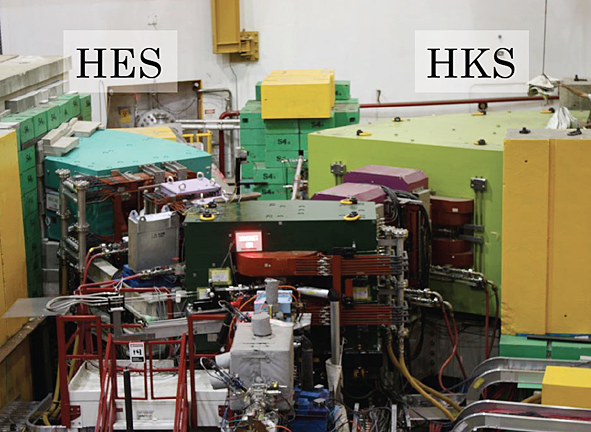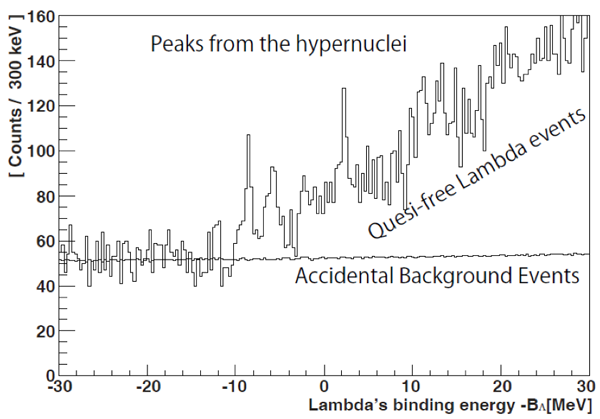NEWS
New spectroscopy of 10ΛBe hypernucleus redefines the reference data of Lambda hypernuclei
A team of international researchers has successfully measured precise binding energy of a  e hypernucleus made of four protons (ρ), five neutrons (n) and and a Lambda (Λ) particle, at Thomas Jefferson National Accelerator Facility (JLab), USA.
e hypernucleus made of four protons (ρ), five neutrons (n) and and a Lambda (Λ) particle, at Thomas Jefferson National Accelerator Facility (JLab), USA.
The research team, known as HKS Collaboration, consists of 76 members from 21 institutes led by Tohoku University, Hampton University and Florida International University.
All materials are made of small charged particles: nuclei and electrons. A nucleus consists of protons and neutrons that are bound by the nuclear force against Coulomb repulsion.
Without the nuclear force, no material can exist stably. Therefore, understanding it is essential to knowing how our material world was created.
A proton has positive charge and a neutron has no charge. Therefore the Coulomb force between proton-proton is repulsive and the Coulomb force does not work between neutron-neutron. However, it is widely known that the nuclear forces between proton-proton and neutron-neutron are almost the same and this is one of most basic features of the nuclear force. This is called as the charge symmetry of the nuclear force.
Modern physics is trying to understand the nuclear force as a part of a more general "baryonic force." A Lambda hypernucleus consists of a Lambda particle, the lightest baryon with strangeness, in addition to protons and neutrons, so the study of Lambda hypernuclei extends our knowledge of the nuclear force to the more general "baryonic force".
There have been long discussions about whether the charge symmetry is also satisfied between Lambda-proton (Λρ) and Lambda-neutron (Λn) systems. Recent experimental studies have revealed that the charge symmetry is largely broken for light hypernuclei, and
and  e [1,2].
e [1,2].
Though its origin is still under debate, comparison of the newly measured e binding energy with that of its mirror hypernucleus
e binding energy with that of its mirror hypernucleus  shows small charge symmetry breaking for heavier hypernuclei. Small charge symmetry breaking for
shows small charge symmetry breaking for heavier hypernuclei. Small charge symmetry breaking for  e −
e −  will shed light on the source of charge symmetry breaking of the ΛΝ interaction. Furthermore, the existence of 0.54 MeV shift is suggested for the reported binding energies of
will shed light on the source of charge symmetry breaking of the ΛΝ interaction. Furthermore, the existence of 0.54 MeV shift is suggested for the reported binding energies of  which has been serving as the mass reference for various hypernuclei.
which has been serving as the mass reference for various hypernuclei.
This shift would affect all reported hypernuclear binding energies calibrated with and it has great impact on hypernuclear study.
and it has great impact on hypernuclear study.
[1] Recent experimental result on performed at MAMI by international collaboration of Tohoku University, Mainz University and others.
performed at MAMI by international collaboration of Tohoku University, Mainz University and others.
A.Esser, S.Nagao, et al., Physical Review Letters 114, 232501 (2015).
http://www.tohoku.ac.jp/japanese/2015/06/award20150625-01.html
[2] Recent experimental result on e performed at J-PARC by international collaboration of Tohoku University, KEK, JAEA and others.
e performed at J-PARC by international collaboration of Tohoku University, KEK, JAEA and others.
T.O.Yamamoto, et al. Physical Review Letters 115, 222501 (2015).
http://www.tohoku.ac.jp/japanese/2015/11/press20151125-02.html
 Figure 1:The magnetic spectrometers, HKS (High resolution Kaon Spectrometer) and HES (High resolution Electron spectrometer) used for the experiment. These spectrometers were constructed and tested in Japan and then shipped to JLab.
Figure 1:The magnetic spectrometers, HKS (High resolution Kaon Spectrometer) and HES (High resolution Electron spectrometer) used for the experiment. These spectrometers were constructed and tested in Japan and then shipped to JLab.
(Credit: Tohoku University)
 Figure 2:The measured binding energy spectrum of
Figure 2:The measured binding energy spectrum of  e. Sharp peaks originating from hypernuclei are clearlyobserved on accidental coincidence background and quasi-freely produced Lambda events.
e. Sharp peaks originating from hypernuclei are clearlyobserved on accidental coincidence background and quasi-freely produced Lambda events.
Publication Details:
Authors: T.Gogami, et al. (HKS (JLab E05-115) Collaboration),
Title: High resolution spectroscopic study of
Journal: Phys. Rev. C 93, 034314.
DOI: 10.1103/PhysRevC.93.034314
Embargo date: Published 10 March 2016
Contact:
Prof. Satoshi N. Nakamura
Graduate School of Science, Tohoku University
Email: nue*tohoku.ac.jp(Replace * with @)
Posted on:April 7, 2016
The research team, known as HKS Collaboration, consists of 76 members from 21 institutes led by Tohoku University, Hampton University and Florida International University.
All materials are made of small charged particles: nuclei and electrons. A nucleus consists of protons and neutrons that are bound by the nuclear force against Coulomb repulsion.
Without the nuclear force, no material can exist stably. Therefore, understanding it is essential to knowing how our material world was created.
A proton has positive charge and a neutron has no charge. Therefore the Coulomb force between proton-proton is repulsive and the Coulomb force does not work between neutron-neutron. However, it is widely known that the nuclear forces between proton-proton and neutron-neutron are almost the same and this is one of most basic features of the nuclear force. This is called as the charge symmetry of the nuclear force.
Modern physics is trying to understand the nuclear force as a part of a more general "baryonic force." A Lambda hypernucleus consists of a Lambda particle, the lightest baryon with strangeness, in addition to protons and neutrons, so the study of Lambda hypernuclei extends our knowledge of the nuclear force to the more general "baryonic force".
There have been long discussions about whether the charge symmetry is also satisfied between Lambda-proton (Λρ) and Lambda-neutron (Λn) systems. Recent experimental studies have revealed that the charge symmetry is largely broken for light hypernuclei,
Though its origin is still under debate, comparison of the newly measured
This shift would affect all reported hypernuclear binding energies calibrated with
[1] Recent experimental result on
A.Esser, S.Nagao, et al., Physical Review Letters 114, 232501 (2015).
http://www.tohoku.ac.jp/japanese/2015/06/award20150625-01.html
[2] Recent experimental result on
T.O.Yamamoto, et al. Physical Review Letters 115, 222501 (2015).
http://www.tohoku.ac.jp/japanese/2015/11/press20151125-02.html
 Figure 1:The magnetic spectrometers, HKS (High resolution Kaon Spectrometer) and HES (High resolution Electron spectrometer) used for the experiment. These spectrometers were constructed and tested in Japan and then shipped to JLab.
Figure 1:The magnetic spectrometers, HKS (High resolution Kaon Spectrometer) and HES (High resolution Electron spectrometer) used for the experiment. These spectrometers were constructed and tested in Japan and then shipped to JLab.(Credit: Tohoku University)
 Figure 2:The measured binding energy spectrum of
Figure 2:The measured binding energy spectrum of Publication Details:
Authors: T.Gogami, et al. (HKS (JLab E05-115) Collaboration),
Title: High resolution spectroscopic study of
Journal: Phys. Rev. C 93, 034314.
DOI: 10.1103/PhysRevC.93.034314
Embargo date: Published 10 March 2016
Contact:
Prof. Satoshi N. Nakamura
Graduate School of Science, Tohoku University
Email: nue*tohoku.ac.jp(Replace * with @)
Posted on:April 7, 2016




